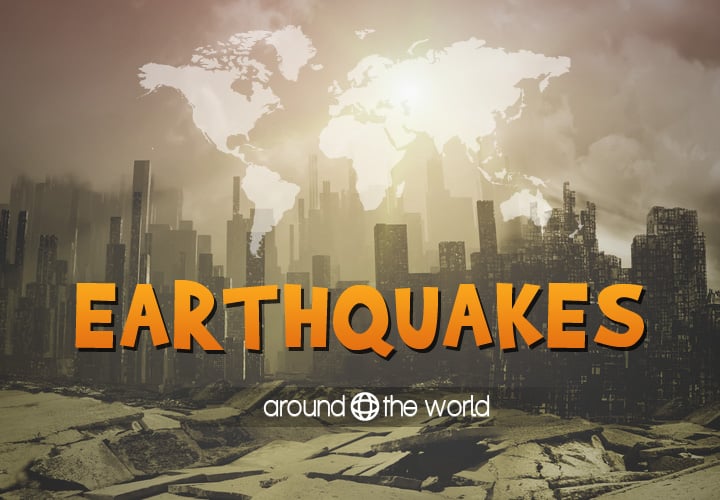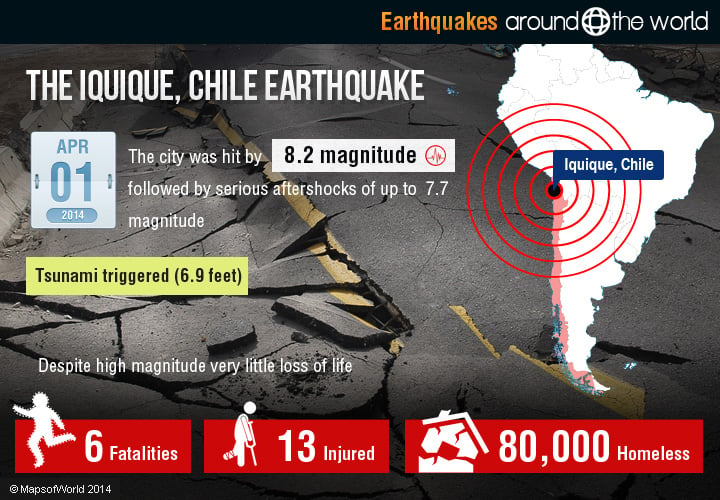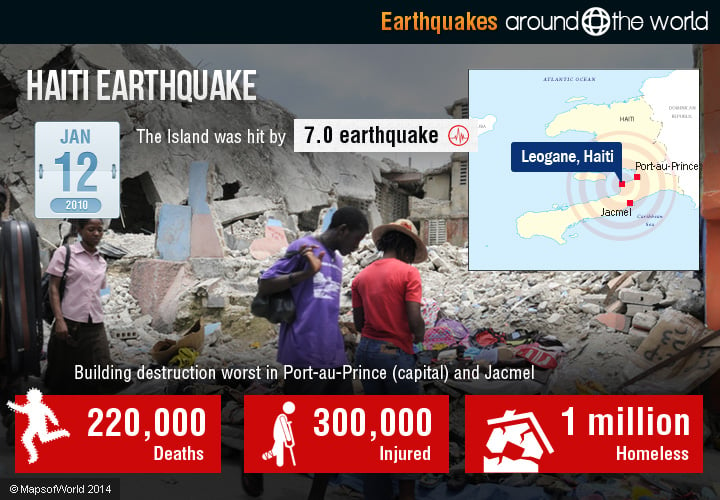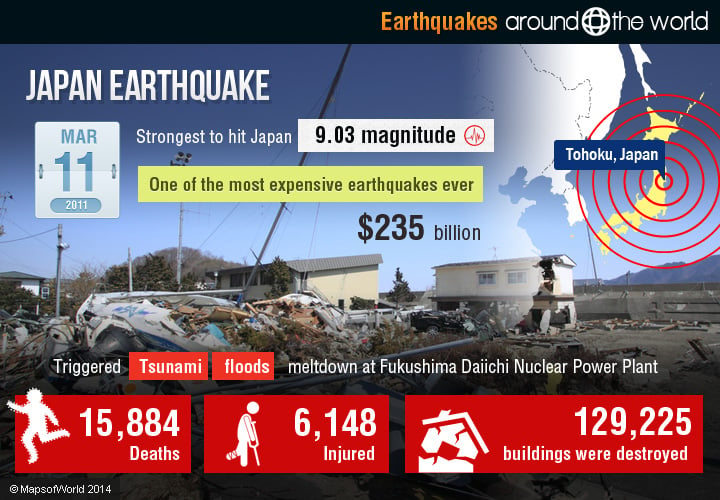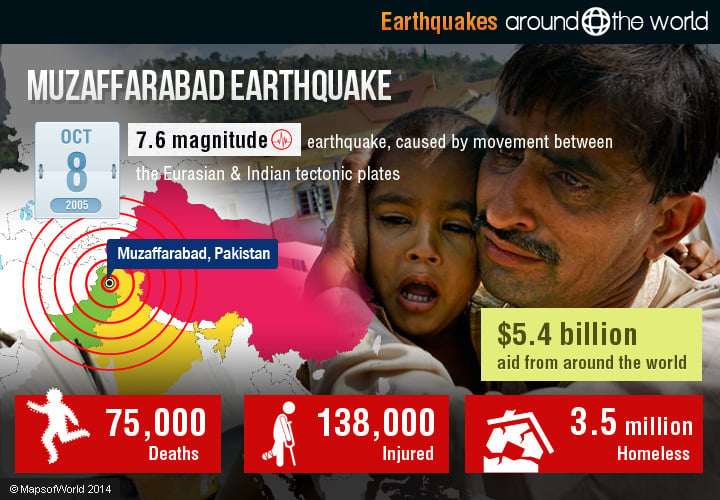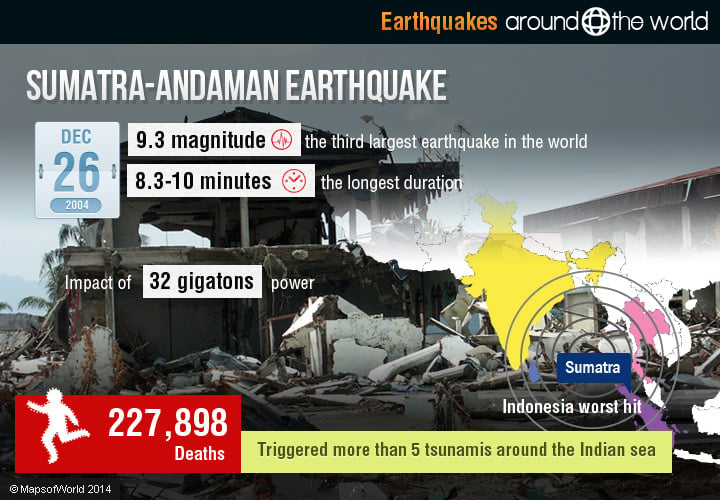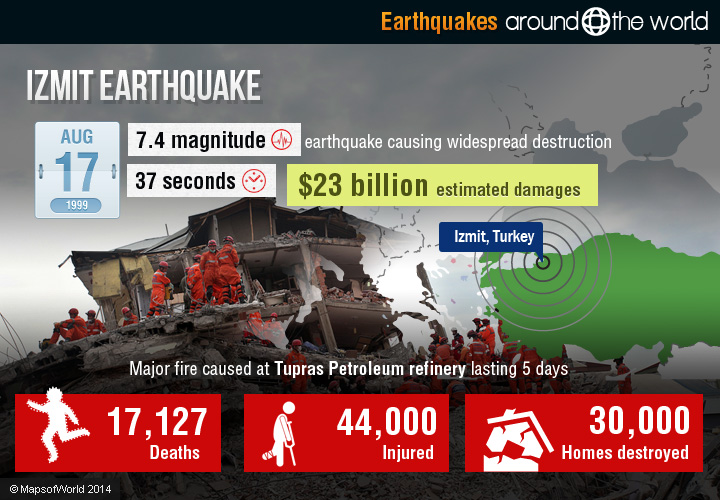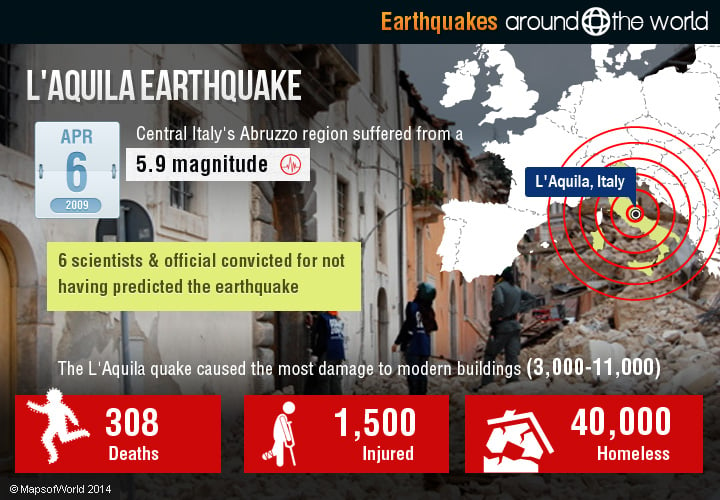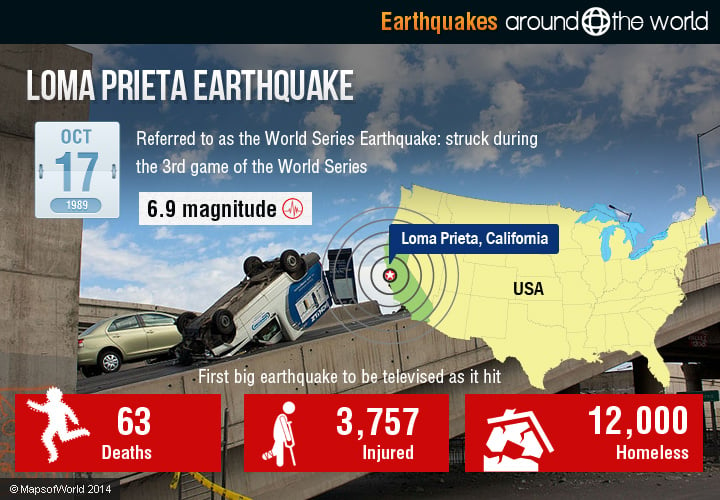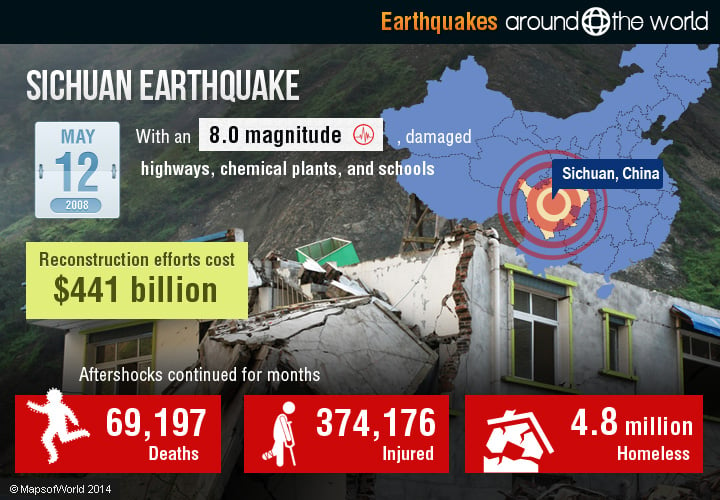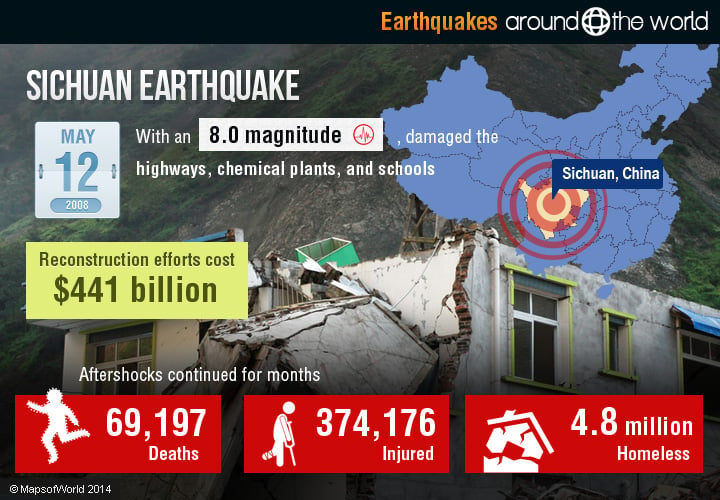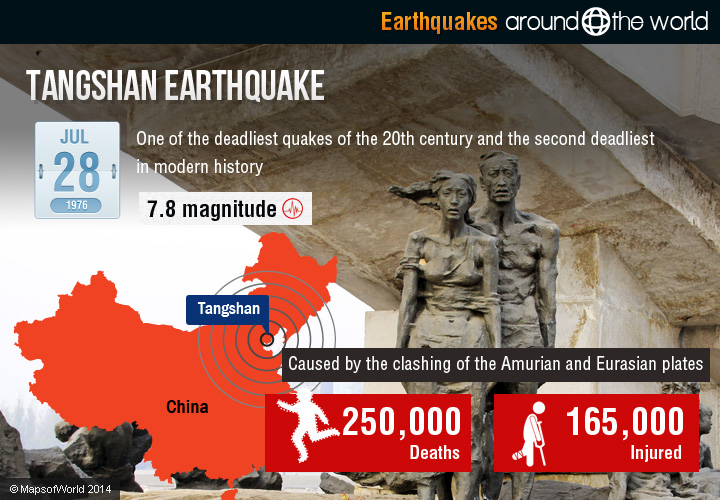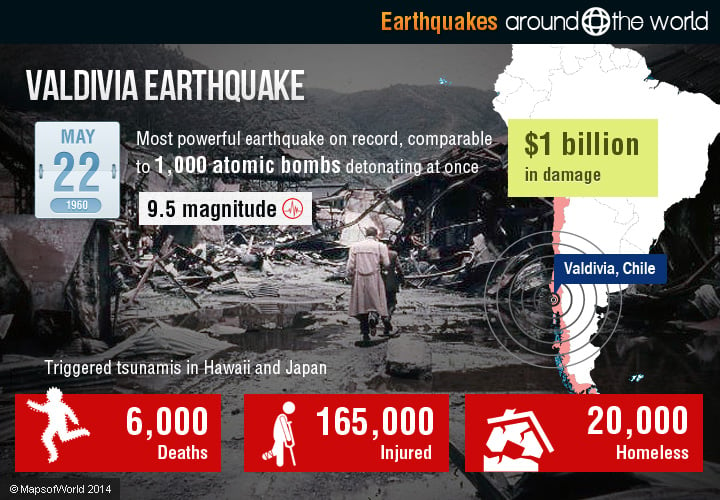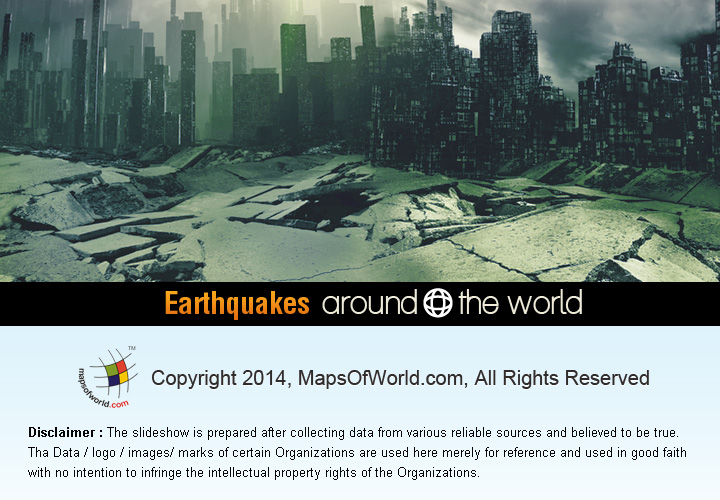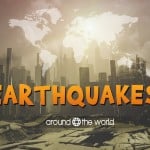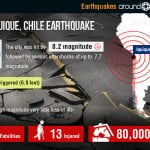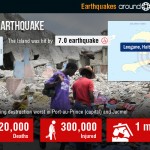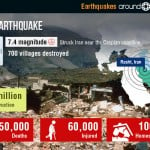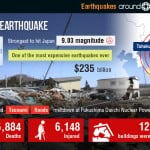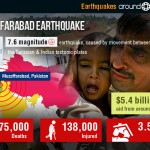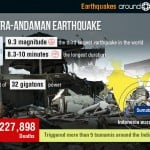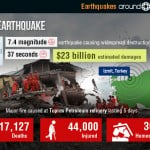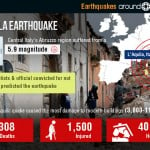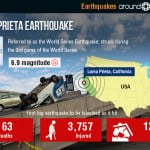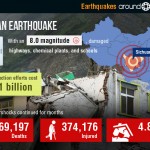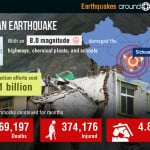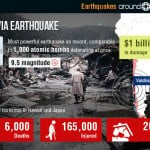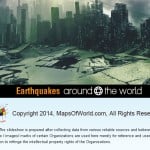Earthquakes Around the World
Earthquakes are one of the most devastating types of natural disasters on the planet, with no way to predict them in advance and only so much we can do to prepare for them. Caused by the Earth’s ever-shifting tectonic plates slipping, sliding, and clashing against one another, the pressure between the plates is released, causing the earth to shake along the fault. Earthquakes can cause and be caused by a number of other natural disasters, including volcanic eruptions, mudslides, tsunamis, and floods.
While earthquakes occur almost constantly around the world – according to USGS data, since 1900, there have been an average of over 14,000 earthquakes with a magnitude of 4 or higher every year and about 150 per year with a magnitude of 6 or greater, only some of them cause extreme devastation. Many of these occur in unpopulated areas or even under the oceans, so we often never even hear about them. The most common place for earthquakes to occur is around the Pacific Rim of Fire, at the edge of the Pacific plate, with coastal regions and island nations the whole way around. Earthquakes have the largest impact on cities where the population density is higher and the tall buildings and extra infrastructure create a higher potential for destruction. The coasts where tsunamis reach are also some of the hardest hit areas after an earthquake.
With the many recent earthquakes off the coast of Oregon and Washington, those in Los Angeles, Wyoming, and in Chile have many worried that the Big One is on its way. The Wyoming earthquake has caused speculation that a supervolcano eruption is soon to come, which would destroy the surrounding states.
Here’s a look at some of history’s largest earthquakes around the world.
2014 Earthquake in Iquique, Chile
On April 1, 2014, an 8.2 earthquake hit 95 kilometers (59 miles) off the coast of the Chilean city of Iquique, followed by serious aftershocks of up to 7.7 magnitude. There were also foreshocks of up to 6.7 magnitude back in mid-March. The earthquakes triggered tsunamis, reaching heights of 2.11 meters (6.9 feet) on the Chilean coast.
Despite the high magnitude of the earthquake, there were only 6 fatalities and about 13 injured in the incident. About 80,000 people were left homeless, and almost 300 prisoners were able to escape because of a damaged building.
2011 Japan Earthquake
The 2011 Japan Earthquake was one of the worst recent earthquakes in the world, with a 9.03 magnitude – the strongest to ever hit Japan in recorded history and the fourth or fifth largest earthquake ever on record. On March 11, 2011, the devastating earthquake struck off the coast of Tohoku, Japan, under the sea. The earthquake caused the Earth to move about 10-25 centimeters (4-10 inches) on its axis, and even moved the Japanese island of Honshu about 2.4 meters (8 feet) to the east. There were over 1,000 aftershocks, 80 with a magnitude of 6.0 or greater.
The earthquake triggered a series of other events, including major tsunamis, floods, fires, landslides, and a nuclear emergency. The tsunamis reached 6 to 8 meters on the shores of northern Japan at Miyagi, covering an area of 561 square kilometers (217 square miles), and reached places like Chile and Alaska entirely across the Pacific. Additionally, the tsunami and floods caused a level 7 meltdown at several of the reactors at Fukushima Daiichi Nuclear Power Plant, with 3 explosions and major evacuations.
Overall there were about 15,884 deaths, 6,148 injured, 2,633 missing, and the earthquake and resulting tsunami affected 20 of Japan’s prefectures. About 129,225 buildings were destroyed, and the combined disaster ended up being one of the most expensive ever, with a cost of about $235 billion.
2010 Haiti Earthquake
One of the most recent earthquakes around the world, a 7.0 earthquake hit Haiti on January 12, 2010, causing major destruction and taking many lives. The epicenter of the quake was about 25 kilometers west of Port-au-Prince (the capital), near the city of Leogane, Haiti. There were more than 52 aftershocks of greater magnitude than 4.5 over the 12 days after the main earthquake.
The earthquake affected an estimated 3 million people, caused up to 220,000 deaths, left 300,000 people injured, and about 1 million homeless. The death toll was so high that the government struggled dealing with the bodies, with many ending up in mass graves, stacked in tombs, and burned. Building destruction was the worst in Port-au-Prince and Jacmel, with a total of about 250,000 homes and 30,000 commercial buildings destroyed.
2009 L’Aquila Earthquake
Central Italy’s Abruzzo region suffered from a 5.9 magnitude earthquake on April 6, 2009, with thousands of aftershocks, over 30 with a magnitude of more than 3.5. There were also two foreshocks the day before the main one. The epicenter was located near L’Aquila, the region’s capital, in the mountains, and was felt across the center of the country, including in the regions of Lazio, Marche, Umbria, and Campania.
While Italy experiences somewhat frequent earthquakes, though they are not often large or devastating. With the medieval buildings of Italy, destruction of architecture is a serious problem, as they are not built to withstand the movement. However, the L’Aquila quake caused the most damage to modern buildings. Between 3,000 and 11,000 buildings were damaged in the 2009 earthquake. There were 308 fatalities and about 1,500 injuries in the quake, and about 40,000 were left homeless.
The controversy surrounding the 2009 L’Aquila earthquake is that in the aftermath of the disaster, six scientists and a government official were convicted of multiple manslaughter because they did not predict the earthquake. They each received sentences of 6 years in prison. The move to imprison these experts has been widely criticized.
2008 Sichuan Earthquake
On May 12, 2008, and earthquake with a magnitude of 8.0 struck the Sichuan province of China, causing severe destruction across the country. Its epicenter about 80 kilometers (50 miles) from Chengdu, and was felt strongly in Beijing and Shanghai, and also felt in nearby countries. There were between 60 and 100 aftershocks with magnitudes of 4.0 to 6.1 over the days following the first quake. Aftershocks continued for months.
The death toll from the Sichuan Earthquake was 69,197, most of which were in the Sichuan province. There were 374,176 reported injuries and at least 4.8 million people were left homeless.
There was major infrastructural damage, including major highways, chemical plants, and schools. There were also major lasting effects to agriculture and livestock. Reconstruction efforts cost the government about $441 billion.
2005 Muzaffarabad Earthquake
A 7.6 magnitude earthquake hit Pakistan occupied Kashmir on October, 8, 2005. The earthquake, caused by movement between the Eurasian and Indian tectonic plates (which created the Himalayas), had its epicenter 19 kilometers (12 miles) from Muzaffarabad, and was felt all the way to China and Tajikistan.
There were upwards of 75,000 deaths caused by the earthquake, around 70% of which were in Muzaffarabad. Some estimates place the total casualties at 100,000. About 138,000 were injured and around 3.5 million people lost their homes in the disaster. The devastation hit school buildings, hospitals, and even basic infrastructure like roads and water. The country received more than $5.4 billion in aid from countries around the world.
2004 Sumatra-Andaman Earthquake
The Indian Ocean Earthquake hit on December 26, 2004, with a magnitude between 9.1 and 9.3, making it the third largest earthquake in the world ever on record, striking with the impact of 32 gigatons of power. It lasted between 8.3 and 10 minutes, the longest duration of any ever, and knocked Earth up to a centimeter. The quake hit the sea bed under the Indian Ocean off the western coast of Sumatra, Indonesia, but it triggered other earthquakes, even in Alaska, and more than 5 tsunamis around the Indian Sea.
As one of the worst natural disasters ever, and certainly the worst recent earthquake around the world, the earthquake hit Indonesia the worst, but also caused severe devastation to Sri Lanka, India, and Thailand. The resulting tsunamis caused much of the damage, reaching even Struisbaai, South Africa (8,500 km/5,300 miles away) and Antarctica.
The death toll stands at 227,898, making it one of the top ten deadliest in history, and the worst tsunami in history. Several of the deaths occurred in parts of Africa, while the majority were in Indonesia, Sri Lanka, India, and Thailand. Rescue and reconstruction efforts received over $14 billion in aid from around the world.
1999 Izmit Earthquake (Turkey)
A 7.4 magnitude earthquake struck nearby the Turkish city of Izmit on August 17, 1999, causing widespread destruction. The quake continued for 37 seconds, but left long-lasting devastation across the region, including at least 17,127 casualties (and estimates reaching 45,000), 44,000 injured, and up to half a million people displaced from their homes. Buildings were also heavily damaged, with an estimated $23 billion in damages, and about 30,000 homes destroyed, and 6,000 heavily damaged or collapsed buildings. Other damage included the country’s infrastructure like bridges, viaducts, and tunnels. The earthquake’s damage reached Istanbul, about 70 kilometers (43 miles) from the epicenter. A side effect of the earthquake was a major fire at the Tupras petroleum refinery, which raged for 5 days and destroyed 17 tanks.
1990 Iran Earthquake
On June 21, 1990, a magnitude 7.4 earthquake struck Iran near the Caspian coastline, off the city of Rasht, and about 200 kilometers from Tehran. The devastation from the earthquake left up to 50,000 people dead and 60,000 injured, affecting the cities of Rudbar, Manjil, and Lushan. An estimated 700 villages were destroyed by the earthquake, with 100,000 adobe houses damaged and about half a million people left homeless. The damage cost an estimated $200,000,000 for reconstruction in Gilan and Zanjan.
1989 Loma Prieta Earthquake (San Francisco)
One of the most famous earthquakes around the world, and especially in earthquake-prone California was the Loma Prieta earthquake of 1989, referred to as the World Series Earthquake, as it struck during the 3rd game of the World Series, which was a Battle of the Bay between the Oakland A’s and San Francisco Giants. The earthquake’s epicenter was near Santa Cruz and Loma Prieta Peak, along the San Andreas Fault.
The earthquake measured 6.9 and was the first big earthquake to be televised as it hit. The earthquake’s damage included a death toll of 63, and left a total of 3,757 people injured and up to 12,000 homeless. There was major structural damage to the Bay Area, especially in the cities of San Francisco and Oakland: the upper-level on a double-decker freeway collapsed, part of the Bay Bridge (between Oakland and San Francisco) collapsed, and a Santa Cruz mall collapsed.
1976 Tangshan Earthquake (China)
On July 28, 1976, a 7.8 magnitude (with other estimates reaching 8.2) earthquake struck northeastern China, in one of the deadliest quakes of the 20th century and the second deadliest in modern history. The epicenter, near Tangshan in the Hebei region, a densely populated region, causing major devastation and taking close to 250,000 lives. Another 165,000 people were seriously injured in the incident.
The main quake lasted about 15 seconds and was followed by an aftershock of 7.1 magnitude less than a day later. The Tangshan earthquake was created by the clashing of the Amurian and Eurasian plates. The shaking was felt in Xi’an, which is 760 kilometers (470 miles) from the epicenter, and damage was seen in buildings even in Beijing.
1960 Valdivia Earthquake (Chile)
The Great Chilean Earthquake occurred on May 22, 1960, near the Chilean coastal city of Lumaco, and is one of the most famous earthquakes around the world. This was the most powerful earthquake on record – registering 9.5 on the moment magnitude scale. The quake was just one of a series of earthquakes to hit the region, beginning with a few near Concepcion on May 21 and 22, continuing with the most devastating quake in Valdivia on May 22, and additional aftershocks through to June 6.
The massive 9.5 quake in Valdivia was felt all the way in Hawaii (435 miles away), and resulted in 6,000 deaths and about $1 billion in damages. The earthquake was equivalent to 178 gigatons of power, comparable to 1,000 atomic bombs detonating at once. In Valdivia, about 40% of homes were devastated, affecting 20,000 residents, leaving them homeless.
The quake triggered several other major disasters, including landslides, floods, tsunamis reaching the coasts of Chile, Hawaii, Japan, the Philippines, Hong Kong, New Zealand, Australia, and Alaska. The tsunamis were devastating in Hawaii and Japan, killing 61 and 142 respectively. Another disaster triggered by the earthquake was the eruption of the Cordon Caulle, a volcano in the Andes, from May 24 to July 22.
Recent Earthquake:


